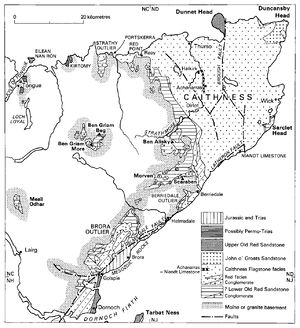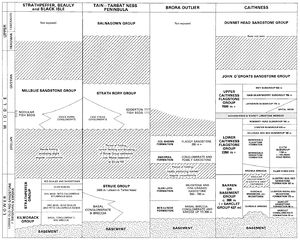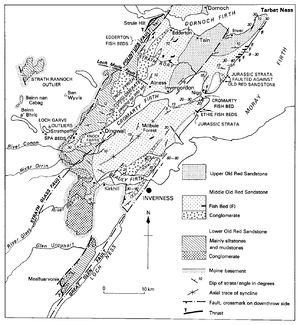Lower Old Red Sandstone, Northern Highlands of Scotland: Difference between revisions
m (1 revision imported) |
No edit summary |
||
| (One intermediate revision by one other user not shown) | |||
| Line 1: | Line 1: | ||
{{NHRG}} | |||
== Caithness and northern Sutherland == | == Caithness and northern Sutherland == | ||
[[File:P915486.jpg|thumbnail|Old Red Sandstone of Caithness and Sutherland. P915486.]] | |||
[[File:P915488.jpg|thumbnail|Correlation shart of the Old red Sandstone of the Northern Highlands. P915488.]] | |||
[[File:P915489.jpg|thumbnail|Sections across the Old Red Sandstone of Sutherland and Easter Ross. P915489.]] | |||
[[File:P915487.jpg|thumbnail|Old Red Sandstone of Easter Ross and Inverness-shire. P915487.]] | |||
Beds ascribed to the Lower Old Red Sandstone crop out in a small anticlinal area around Sarclet Head in eastern Caithness, and in a larger outcrop extending along the western margin of the Caithness Old Red Sandstone outcrop, from Reay to Berriedale ([[Media:P915486.jpg|P915486]]). The best documented section is that of the Sarclet Anticline, where the Sarclet Group ([[Media:P915488.jpg|P915488]]) contains the following formations (Donovan, 1970): | Beds ascribed to the Lower Old Red Sandstone crop out in a small anticlinal area around Sarclet Head in eastern Caithness, and in a larger outcrop extending along the western margin of the Caithness Old Red Sandstone outcrop, from Reay to Berriedale ([[Media:P915486.jpg|P915486]]). The best documented section is that of the Sarclet Anticline, where the Sarclet Group ([[Media:P915488.jpg|P915488]]) contains the following formations (Donovan, 1970): | ||
Latest revision as of 11:50, 1 February 2018
| Johnstone, G S and Mykura, W. 1989. British regional geology: Northern Highlands of Scotland. Fourth edition. Keyworth, Nottingham: British Geological Survey. |
Caithness and northern Sutherland




Beds ascribed to the Lower Old Red Sandstone crop out in a small anticlinal area around Sarclet Head in eastern Caithness, and in a larger outcrop extending along the western margin of the Caithness Old Red Sandstone outcrop, from Reay to Berriedale (P915486). The best documented section is that of the Sarclet Anticline, where the Sarclet Group (P915488) contains the following formations (Donovan, 1970):
| Formations | Thickness (m) | |
| 4 | Ulbster/Ires Geo Sandstone Formation | 107 |
| 3 | Ulbster/Riera Geo Mudstone Formation | 172 |
| 2 | Sarclet Sandstone Formation | 85 |
| 1 | Sarclet Conglomerate Formation | 70 |
The Sarclet Conglomerate is made up of lenses of conglomerate and pebbly sandstone, with pebbles of granite, schist, quartzite, sandstone and basalt. The conglomerate and overlying Sarclet Sandstone appear to have been laid down by braided rivers and meandering rivers from the south-east. The Ulbster/ Riera Geo Mudstone Formation is a rhythmic sequence, mainly of hard green mudstones with some thin calcareous marls, siltstones and sandstones. It appears to have been deposited in a shallow lake which periodically receded to give place to a deltaic alluvial plain. The Ulbster/Ires Geo Sandstone Formation consists of a thin lower sequence of red sandstone, lain down by small rivers and streams, overlain by grey mudstone of lacustrine origin, which, in turn, passes upward into fairly coarse red fluvial sandstone and grit. Miospores from a bed of grey-green mudstone 15 cm thick intercalated with the sandstone indicate an Upper Emsian age for the deposit (Collins and Donovan, 1977). The top of the formation is interdigitated with the Ellens Geo Conglomerate, which has been taken as the local base of the Middle Old Red Sandstone (P915488).
In the Berriedale Outlier (P915486) the Lower Old Red Sandstone rests on the Helmsdale Granite. Its basal member, locally termed the Ousdale Arkose, contains a conglomerate, but elsewhere consists of redeposited, unweathered granite debris which is difficult to distinguish from the underlying granite. The overlying Ousdale Mudstone (seen in road cuttings and in a quarry north of the Ord of Caithness) consists of purple, pale green and red siltstones and mudstones alternating with thin beds of locally pebbly sandstone. The sandy siltstones have yielded unidentifiable plant remains. Miospores and a scale of Porolepis suggest a high Lower Devonian (Lower Emsian) age (Richardson, 1967; Collins and Donovan, 1977).
The Lower Old Red Sandstone was gently folded and eroded prior to the deposition of the Badbea Breccia, the basal member of Middle Old Red Sandstone in this area; the breccia oversteps on to the metamorphic basement.
North of Scaraben (P915486), Lower Old Red Sandstone forms an irregular outcrop along the western margin of the Caithness plain, with two westward- projecting tongues in the Morven and Ben Alisky districts. In this belt there are a number of lenticular outcrops of basal arkosic conglomerate and breccia, the pebbles of which can be closely matched with the lithology of the local basement. Over a large part of the outcrop, however, fine-grained purplish flaggy sandstones, mudstones and siltstones (the ‘Braemore Mudstones’) rest directly on the basement. The Lower Old Red Sandstone beds of this belt are steeply inclined in some places, but more generally they are concordant with the overlying Middle Old Red Sandstone. At its northern end, around Reay, the belt of Lower Old Red Sandstone beds is discontinuous, the isolated outcrops representing infilled N–S-trending pre-Old Red Sandstone valleys.
In the Strathy Outlier (P915486), conglomerates and arkoses of probable Lower Old Red Sandstone age occupy the southern part of the outcrop. The age of the three outliers around Ben Griam More and Ben Griam Beg is not certain. The sediments rest on a very uneven floor and the sequence, as seen in the largest outlier, is as follows, (Read, 1931, pp.205–207).
4 Arkose, red, cross-bedded with pebbly bands at base, but becoming yellow and massive at top
3 Conglomerate, with quartzite pebbles in arkosic matri
2 Arkose, reddish, with conglomerate bands and some thin red mudstones with suncracks near top
1 Basal conglomerate and breccia-conglomerate, locally with huge boulders of local origin
No fossils have been obtained from these beds: on lithological grounds alone they could be ascribed to either the Lower or the Middle Old Red Sandstone. However, formations 1 and 2 show some similarities to the Lower Old Red Sandstone of western Caithness, and formations 3 and 4 may be fluviatile facies of Middle Old Red Sandstone age, broadly similar to the Middle Old Red Sandstone of the Brora Outlier (p.134). Further south-west, the outlier of Meall Odhar, 15 km north of Lairg, is probably entirely of Lower Old Red Sandstone age. It consists of red and chocolate micaceous sandstones with ripple marks and possible worm casts, passing upwards by interdigitation into coarse conglomerate (Read, 1931). Its probable Lower Old Red Sandstone age is, again, based largely on lithological comparison.
East Sutherland
The Old Red Sandstone of east Sutherland forms an irregular, partly fault- bounded outcrop extending from just south of the Strath of Kildonan to the Dornoch Firth. The part west of the Helmsdale Fault is known as the Brora Outlier, which forms a series of prominent hills. It has the structure of a basin elongated in a north-easterly direction. It contains two groups of strata separated by a marked angular unconformity (P915488, P915489a). No fossils have been found, but the lower group is taken to be of Lower Old Red Sandstone age: it is lithologically similar to the spore-bearing Lower Old Red Sandstone of southern Caithness. The basal breccia and conglomerate (the Ben Lundie Formation) of the ?Lower Old Red Sandstone forms an almost continuous outcrop along the western and southern margins of the Brora Outlier and forms the hills north and west of Loch Fleet. It is thickest and coarsest in the south; in the craggy hills south-west and west of Golspie it contains angular boulders up to 60 cm in diameter set in a red gritty matrix and intercalated with impersistent sandstones. The boulders consist of schists and granite of the types which crop out immediately to the west; it is probable that the breccia was deposited as screes and torrential fan deposits at the foot of the fault-bounded hills lying to the west.
Above the basal conglomerates are pebbly sandstones which are in turn overlain by fine-grained, red and purple, ripple-marked sandstones, then locally by mudstones, and finally, by hard flaggy red sandstones (the Glen Loth Formation). The sandstones and mudstones have some sun-cracked surfaces, and there are several beds of desiccation-breccia. The mudstones are best developed at the north-eastern end of the outlier where they reach a thickness of 500 m. They are the probable equivalents of the Ousdale/Braemore Mudstones of southern Caithness and, like the latter, they were probably laid down in a shallow lake.
Ross and Cromarty
The Old Red Sandstone south of the Dornoch Firth forms an open syncline trending south-west, the axial trace of which extends south-westwards from Inver through the centre of the Black Isle to the vicinity of Beauly (P915487). Sediments of probable Lower Old Red Sandstone age, termed the Struie Group (Armstrong, 1977), form a continuous outcrop along the western margin of the syncline. Their contact with the underlying Moine is in part an unconformity and in part a fault; on Struie Hill, folded and faulted beds have been thrust over the Moine basement (P915489b). They consist of lenticular conglomerates intercalated with grey and black flaggy sandstones, siltstones and mudstones. The conglomerates thin out immediately south of Struie Hill, giving place to a fine-grained sequence of dark grey siltstones and calcareous mudstones, which have yielded no determinable fossils. South of the Loch Morie Fault (P915487) breccia and conglomerate are to be seen again, and south of Strathpeffer conglomerate gives rise to a series of prominent hills along the rivers Conon and Orrin. Still further south coarse breccio-conglomerate is exposed in the Aigas Gorge of the River Beauly, where some of the rugged, pre-Old Red topography can be seen (Smith, 1963).
Above the basal breccio-conglomerates the sequence comprises green and grey shales, flagstones, fetid dark shales and calcareous mudstones. In the Strathpeffer district the following succession has been recorded (Home and Hinxman, 1914).
4 Red shales passing up into sandstone (200 m thick)
3 Olive shales with shaly, fetid limestones (85 m thick)
2 Spa Beds: fetid bituminous and calcareous shales with thin limestones (30 m thick)
1 Ord Beds: olive shales with fetid calcareous bands (250–300 m thick)
The fetid beds give off a smell of hydrogen sulphide when hammered and are the source of the ‘sulphur waters’ to which Strathpeffer owes its development as a spa during the 19th century.
Some of the shales and limestones of the Ord Beds contain structures which resemble stromatolites and may be of algal origin. The olive shales have yielded spores of Lower Devonian aspect, which include Emphanisporites and pseudosaccate spores (Richardson, 1967). These are comparable with the spore assemblages obtained from the Lower Old Red Sandstone of Strathmore in the Midland Valley of Scotland. The outcrop of the fetid calcareous shales can be traced southwards from Strathpeffer to Beauly and Kirkhill.
Beds of Lower Old Red Sandstone age have not been recorded on the east limb of the Inver–Black Isle Syncline, and the Moine inliers of Hill of Nigg and Cromarty are directly overlain by conglomerates of the Millbuie Sandstone Group, which is ascribed to the Middle Old Red Sandstone (p.136; P915488, P915489c). In the south-east part of the syncline, Westoll (1977) has equated the Ord Hill conglomerate and overlying sediments with the Lower Old Red Sandstone Strathpeffer beds, but this correlation is not supported by either lithological or fossil evidence.
Western outliers of Ross-shire
The Strath Rannoch Outlier (P915487) is situated some 10 km north-west of Ben Wyvis and consists of sediments which fill a steep-sided valley within metamorphic basement. The sediments comprise coarse massive conglomerates, which give rise to prominent escarpments along the western margin of the outcrop, as well as red fine-grained sandstone and mudstone with thin calcareous bands. The finer-grained sediments crop out in the valley bottoms and along the east side of the outlier. No order of succession has as yet been established and it is likely that there are marked lateral facies changes, owing to the pronounced pre-Old Red Sandstone topography of the area. The coarse conglomerate capping the summit of Meall a’ Ghrianan [NH 366 776], just northwest of the Strath Rannoch outlier, contains huge blocks of locally derived augen gneiss up to 6 m in diameter. In this area the Moine–Old Red Sandstone junction rises about 400 m over a horizontal distance of less than 2 km.
Smaller outliers of Old Red Sandstone breccia and conglomerate crop out on the summits of Beinn nan Cabag [NH 356 670] and Beinn a’ Bhric [NH 345 652], some 5 km south of the Strath Rannoch Outlier (P915487). These sediments were also deposited on a mountainous topography; in one locality the junction with the basement is a steep cliff.
Inverness-shire
Mealfuarvonie
Along the north-west side of Loch Ness a fault-bounded outcrop of tightly folded, faulted and locally thrust sediments extends for 16 km south-west from Glen Urquhart (Mykura and Owens, 1983). This contains nine lenticular masses of breccio-conglomerate and pebbly arkosic grit which give rise to prominent craggy hills; they range in thickness from 50 m to 400 m. These are interbedded with a sequence of at least 1800 m of predominantly planarbedded, reddish, fine-to medium-fine-grained sandstone. Mudstones and siltstones generally form only thin films and intraformational clasts within the sandstone but, near the northeast end of the outcrop, they are thicker. In the extreme north-east a number of pale green mudstones have yielded poorly preserved non-diagnostic plants as well as a rich microflora, which suggest an Emsian or possibly Eifelian age. In the extreme south-west of the outcrop the conglomerates and arkosic grits contain many clasts of granite which must have been derived from a nearby outcrop on the south-east side of the Great Glen Fault. The most likely source for the clasts is the small granite outcrops now exposed on the east side of the Great Glen between Loch Lochy and Loch Oich, suggesting a post-Lower Devonian dextral displacement of the order of 25 km along the Great Glen Fault.
Loch Linnhe
The small outcrop of Old Red Sandstone within the Great Glen Fault Zone at Rubha na h-Earba, 17 km south-west of Fort William, comprises a coarse basal scree-breccia, about 15 m thick, overstepped by an interdigitating sequence of conglomerate and sandstone (Stoker, 1982). The conglomerates represent sheetflood deposits of an alluvial fan, while the sandstones were probably laid down by braided rivers on an alluvial plain. The beds have been faulted, folded and over thrust. Though formerly taken to be of Middle Old Red Sandstone age, Stoker now believes that they may be Lower Devonian. The evidence for this is, however, not conclusive.
Conditions of deposition
It is believed that the Lower Old Red Sandstone rocks were laid down in a number of fault-bounded basins of relatively limited extent. The coarse breccioconglomerates originated as screes and terrestrial fan deposits laid down at the foot of the emerging mountains. The absence of medium-grained fluvial sandstones and the preponderance of siltstones and mudstones among the finergrained sediments suggest that there were no large, swift-flowing rivers at that time, possibly because rainfall was low. Some of the basins contained lakes, which received only fine sediment. The organic content of the Strathpeffer lake must have been high, possibly containing abundant blue green algae and bacteria.